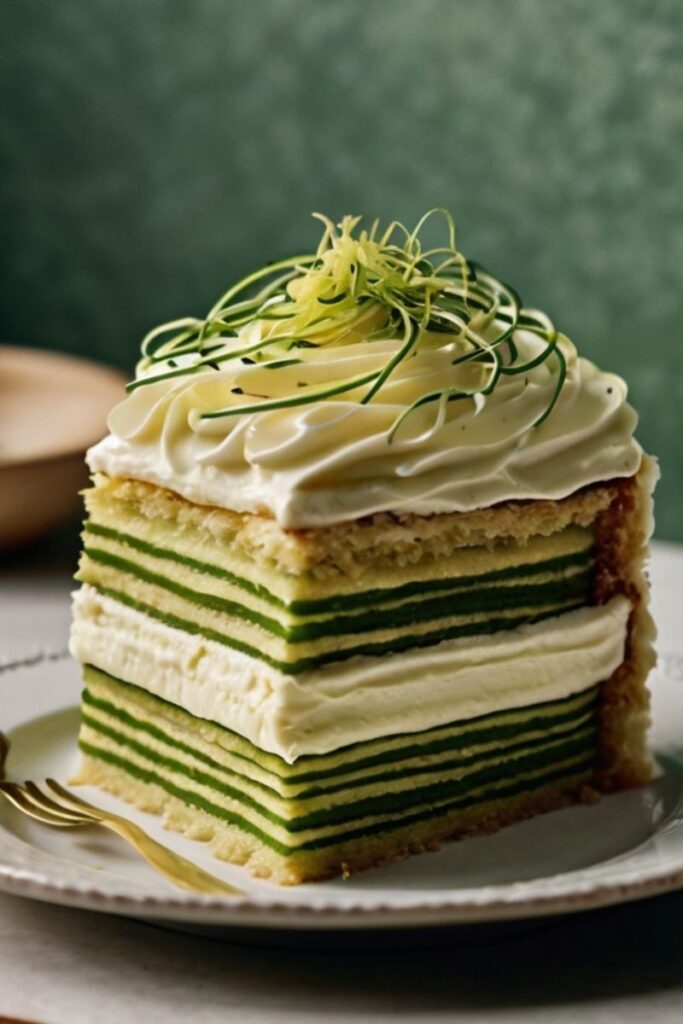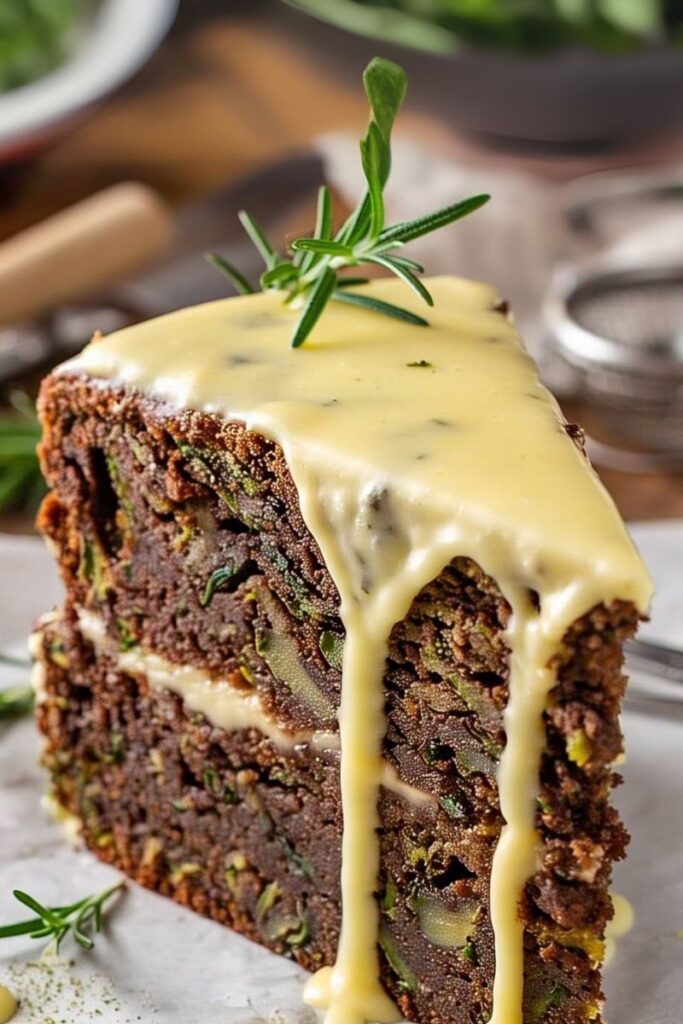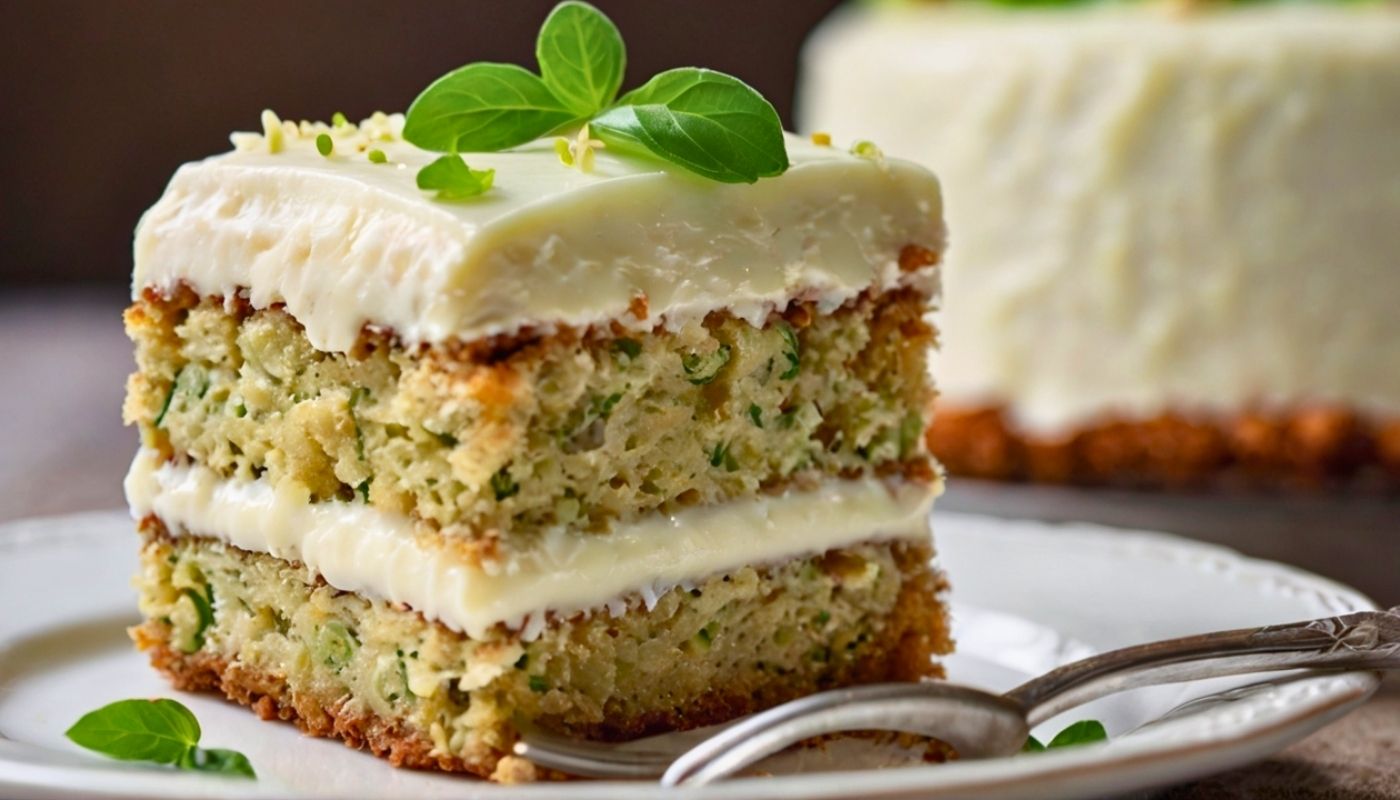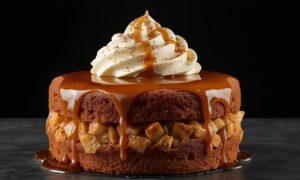What if I told you a green vegetable could make one of the softest, most irresistible cakes you’ve ever had? Sounds strange, but that’s the magic of Zucchini Cake with Cream Cheese Frosting. It’s moist, spiced just right, and topped with a silky, tangy frosting that melts in your mouth. The best part? You won’t even taste the zucchini, but you’ll love what it does to the texture.
This isn’t just another dessert. It’s comfort in every bite. It’s perfect for family gatherings, bake sales, or cozy weekends when you want something homemade and heartwarming. The warm spices, the fluffy crumb, the creamy frosting, it all comes together like a dream.
In this post, I’ll walk you through everything. From how to grate the zucchini just right, to getting that frosting smooth and spreadable. You’ll learn baking tips, ingredient swaps, and how to make it ahead. Whether you’re a seasoned baker or just starting out, this Zucchini Cake with Cream Cheese Frosting will boost your confidence and wow your taste buds. Ready to turn your zucchini into something unforgettable? Let’s get started!
The Magic of Zucchini in Baking
People often react with surprise when I mention zucchini cake. “Vegetables in dessert?” they ask. But zucchini works magic in baking. With about 95% water, it adds incredible moisture without altering the flavor.
Unlike bananas or applesauce, which change the taste, zucchini stays in the background, creating a tender, moist crumb while spices shine. Plus, sneaking in veggies while eating dessert feels a bit delightfully rebellious.
Its cellular structure also helps the cake stay fresh longer. As it bakes, zucchini slowly releases moisture, keeping your cake soft for days. Try that with plain vanilla!
Ingredients & Substitutions
For the Cake:
- 3 cups all purpose flour (13.5 oz/380g)
- 1 teaspoon baking soda
- ½ teaspoon baking powder
- 1½ teaspoons salt (I prefer Diamond Crystal kosher salt)
- 2 teaspoons ground cinnamon
- ½ teaspoon ground nutmeg
- ¼ teaspoon ground cloves
- 1 cup neutral vegetable oil (safflower or canola work best)
- 1¾ cups granulated sugar (12.25 oz/350g)
- 3 large eggs, room temperature
- 2 teaspoons pure vanilla extract
- 3 cups grated zucchini (about 2-3 medium zucchini)
- 1 cup chopped walnuts or pecans (optional)
- ½ cup golden raisins (optional)
For the Cream Cheese Frosting:
- 8 oz (225g) cream cheese, softened but still cool
- ½ cup (1 stick/113g) unsalted butter, softened but still cool
- 3 cups (360g) confectioners’ sugar, sifted
- 1 teaspoon pure vanilla extract
- Pinch of salt
Ingredient Selection & Substitution Insights
Flour: Protein content matters. All-purpose flour (10–12% protein) offers great structure. For a softer crumb, swap up to ⅓ with cake flour. Going gluten-free? Use a blend with xanthan gum and add an extra egg for binding.
Zucchini: The star of the show, don’t hold back. Smaller zucchini have better flavor and fewer seeds. No peeling needed; the green flecks look lovely. Can’t find zucchini? Yellow squash works the same. I’ve even used seeded Lebanese cucumber in a pinch.
Oil vs. Butter: I choose oil for moisture that lasts, even chilled. Prefer butter’s flavor? Swap in half melted butter for richness without sacrificing tenderness.
Sweeteners: You can cut up to ¼ cup sugar with little impact. For depth, replace half with light brown sugar. Coconut sugar works too, it darkens the cake and adds a caramel note.
Spices: Classic cinnamon, nutmeg, and clove never fail. But cardamom adds elegance, and ground or fresh ginger brings warming complexity. Try fresh ginger at least once!
Step by Step Instructions

Preparing the Zucchini
- Trim the ends of your zucchini but do not peel. Using the medium holes of a box grater or the grating disk on a food processor, grate the zucchini. A common mistake is using the smallest holes, which will turn your zucchini to mush and release too much water too quickly.
- Here’s where experienced bakers diverge: some insist on squeezing out excess moisture, while others leave the zucchini untouched. After years of testing, I’ve found that letting the grated zucchini sit in a colander for 10 minutes to drain naturally strikes the perfect balance. Don’t squeeze it bone dry; that moisture is precious for your cake’s texture.
- If your zucchini is particularly watery (which happens with larger, more mature specimens), give it a gentle press with paper towels. You want it damp but not dripping. I measure the zucchini after this draining step.
Making the Cake Batter
- Preheat your oven to 350°F (175°C). Prepare two 9-inch round cake pans by greasing them thoroughly and lining the bottoms with parchment paper. For an absolutely foolproof release, I also dust the sides lightly with flour after greasing.
- In a medium bowl, whisk together the flour, baking soda, baking powder, salt, cinnamon, nutmeg, and cloves until completely combined. Don’t rush this step, proper distribution of the leavening agents is crucial for even rising. This is not the time to cut corners!
- In a large bowl, whisk the oil and sugar vigorously until the mixture lightens slightly in color, about 1-2 minutes. This step dissolves the sugar crystals partially, creating a finer crumb in the finished cake. Add the eggs one at a time, beating well after each addition. The mixture should become thick and almost creamy. Stir in the vanilla extract.
- Add the dry ingredients to the wet ingredients in three portions, gently folding after each addition just until no streaks of flour remain. Overmixing at this stage develops gluten, leading to a tougher cake. When the last addition of flour is almost incorporated but you can still see a few streaks, add the grated zucchini, nuts, and raisins (if using).
- Fold everything together until just combined. The batter will seem thick at first, but as you fold, the moisture from the zucchini will loosen it to a spoonable consistency. It should fall in a ribbon from your spatula when lifted.
- Divide the batter evenly between the prepared pans. To ensure perfectly even layers, I actually weigh my pans each should contain approximately 750-800g of batter. Smooth the tops with an offset spatula.
- Bake in the preheated oven for 30-35 minutes, or until a wooden skewer inserted into the center comes out with just a few moist crumbs attached. Beginning check in at 25 minutes, overbaking is the most common mistake with zucchini cake and will rob you of its signature moisture.
- Place the pans on a wire rack and let them cool for 15 minutes. Run a thin knife around the edges, then invert the cakes onto the rack, remove the parchment, and allow to cool completely before frosting. Rushing this cooling step will cause your frosting to melt. Patience pays off!
Preparing the Cream Cheese Frosting
- In the bowl of a stand mixer fitted with the paddle attachment (or using a hand mixer), beat the cream cheese and butter on medium speed until completely smooth and free of lumps, about 2 minutes. Scrape down the sides and bottom of the bowl frequently to ensure no lumps remain. The temperature of your ingredients is crucial too cold and you’ll get lumps, too warm and the frosting will be slack.
- With the mixer on low speed, gradually add the confectioners’ sugar, vanilla, and salt. Once all the sugar is incorporated, increase the speed to medium and beat until light and fluffy, 1-2 minutes. Avoid overbeating, which can cause the cream cheese to break down and become runny.
- If the frosting seems too soft for spreading, refrigerate it for 10-15 minutes, then briefly re beat before using. For piping decorations, you may need to chill it a bit longer to achieve the right consistency.
Assembling and Frosting the Cake
- Place one cake layer on a serving plate or cake stand. If the layers have domed, level them with a serrated knife for a professional appearance and better stacking stability. Using an offset spatula, spread about a cup of frosting evenly over the top.
- Place the second layer on top, bottom side up to create a perfectly flat surface. Apply a thin layer of frosting over the entire cake to seal in crumbs (this is called a crumb coat), then refrigerate for 15-20 minutes until set.
- Once the crumb coat has set, apply the remaining frosting, creating decorative swirls if desired. For a rustic look, I leave the sides semi naked, with the cake partially visible beneath a thin layer of frosting. For a more refined presentation, fully frost the cake and use a bench scraper to create smooth sides.
- For the finishing touch, press chopped nuts around the bottom edge of the cake if desired, or top with a light dusting of cinnamon or a few decorative zucchini curls made with a vegetable peeler.
Advanced Techniques & Science Behind the Cake
The magic of zucchini cake lies in the interplay between moisture and structure. Zucchini releases water gradually during baking through a process called osmosis. The cell walls of the zucchini break down in the heat, releasing their moisture into the surrounding batter. This slow release is crucial it allows the cake’s structure to set before receiving the full moisture load, preventing a soggy bottom.
The oil in the recipe coats the flour proteins, inhibiting gluten formation and resulting in a tender crumb. Meanwhile, the eggs provide structure through protein coagulation and lecithin emulsification. The balance between these elements creates the perfect texture.
For the absolutely best flavor development, consider making this cake a day ahead. Like many spiced baked goods, the flavor compounds continue to develop and meld overnight. The moisture from the zucchini keeps the cake from drying out, so you don’t sacrifice texture for flavor enhancement.
Baking temperature plays a significant role in texture development as well. The 350°F sweet spot allows the cake to rise properly while the zucchini cells break down at the right pace. Baking at higher temperatures risks setting the exterior before the interior is cooked, while lower temperatures can result in dense, under risen layers.
Serving & Pairing Suggestions

Zucchini cake with cream cheese frosting walks the line between casual comfort and elegant dessert, making it incredibly versatile for different occasions. For a casual gathering, serve thick slices alongside a scoop of cinnamon ice cream or a drizzle of salted caramel sauce.
For a more sophisticated presentation, cut the cake into small, tall squares, place a dollop of frosting on top, and garnish with a candied zucchini ribbon and a sprinkle of toasted walnuts. This presentation elevates the humble cake to dinner party status.
Beverage pairings depend on the time of day. Morning servings pair beautifully with a medium roast coffee with nutty undertones or a chai latte that echoes the cake’s warm spices. For dessert, consider an oaky Chardonnay, a tawny port, or a bourbon based Old Fashioned that complements the cake’s spice profile.
The cake can be transformed into an impressive trifle by cubing it and layering with additional whipped cream cheese, caramel sauce, and toasted nuts. Alternatively, slice it thinly, toast until crisp, and serve as a sophisticated accompaniment to spiced poached pears or roasted stone fruits.
Beyond the Basic Recipe: Creative Variations
The beauty of this foundational recipe lies in its adaptability. Here are some of my favorite variations that I’ve developed over years of zucchini abundance:
Chocolate Zucchini Cake: Replace ½ cup of flour with cocoa powder and add 1 cup of chocolate chips to the batter. The zucchini’s moisture makes this one of the most luscious chocolate cakes you’ll ever taste.
Lemon Zucchini Cake: Add the zest of 2 lemons to the batter and replace the spices with 1 tablespoon of lemon juice. Frost with a lemon cream cheese frosting by adding 1 tablespoon of lemon zest and 2 tablespoons of lemon juice to the basic frosting recipe.
Coconut Pineapple Zucchini Cake: Add 1 cup of drained crushed pineapple and ½ cup of toasted coconut to the batter. Frost with cream cheese frosting that has ½ teaspoon of coconut extract added, and garnish with toasted coconut flakes.
Savory Zucchini Bread: Remove the sugar, vanilla, and spices. Add 1 cup of grated Parmesan, 2 tablespoons of fresh herbs (rosemary, thyme, or dill), and a pinch of black pepper. Skip the frosting and serve with meals instead of dinner rolls.
Storage and Make Ahead Tips
Unfrosted zucchini cake layers can be wrapped tightly in plastic wrap and stored at room temperature for up to 2 days or frozen for up to 3 months. To freeze, wrap each layer individually in plastic wrap, then in aluminum foil. Thaw overnight in the refrigerator before frosting.
Frosted cake should be stored in the refrigerator due to the cream cheese frosting, but always serve at room temperature for the best flavor and texture. Remove the cake from the refrigerator at least 30 minutes before serving. A fully frosted cake will stay fresh in the refrigerator for up to 5 days—though I doubt it will last that long!
Cream cheese frosting can be made up to 3 days ahead and stored in an airtight container in the refrigerator. Before using, bring to room temperature and beat briefly to restore its fluffy texture.
Conclusion: Why This Cake Matters
Zucchini Cake with Cream Cheese Frosting represents everything wonderful about thoughtful baking—it transforms a humble, often overlooked vegetable into something extraordinary. It embodies the principle of seasonal cooking, creating something delicious from local abundance. And perhaps most importantly, it connects us to generations of resourceful home bakers who found creative ways to use what they had.
The perfect Zucchini Cake with Cream Cheese Frosting is more than just a recipe its a testament to understanding ingredients and technique. When you master this cake, you’re not just following instructions; you’re engaging with the science and art of baking in a meaningful way. You’re creating something greater than the sum of its parts.
So next time you’re faced with an abundance of zucchini, don’t just make another loaf of bread. Create this showstopping Zucchini Cake with Cream Cheese Frosting and watch as everyone asks for seconds and then for your recipe. Because sometimes the most impressive dishes come from the most unassuming ingredients.
Frequently Asked Questions
Can I use frozen grated zucchini for this recipe?
Yes, but thaw completely and drain very well. Freezing breaks down cell structure, releasing more water. Squeeze gently and use about 2½ cups instead of 3 to account for the denser texture.
Why did my cake turn out too wet in the middle?
Either your zucchini was extremely watery (older zucchini have higher water content), or the cake was underbaked. Squeeze watery zucchini more thoroughly. For doneness, a few moist crumbs on your tester are perfect—a completely clean tester often means overbaking.
Can I make this cake without nuts for allergy concerns?
Absolutely! Simply omit the nuts with no other adjustments. For texture, consider adding toasted pepitas, sunflower seeds, or white chocolate chips instead.
How do I prevent my cream cheese frosting from becoming runny?
Use ingredients that are cool but pliable (about 65°F). Beat just until smooth and fluffy; overbeating breaks down the cream cheese. If too soft, refrigerate for 15-20 minutes, then beat briefly before using.
Can I make this recipe as cupcakes or a sheet cake?
Yes! For cupcakes, fill liners ⅔ full and bake 18-22 minutes. For a 9×13 inch sheet cake, bake 35-40 minutes. Keep the temperature the same.

Swiftly Captions by Tina Smith — Quick, flavorful food recipes made simple, bringing fresh inspiration to your kitchen every day






